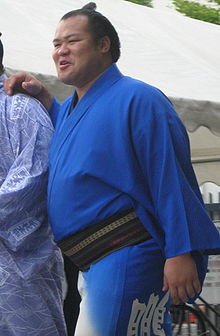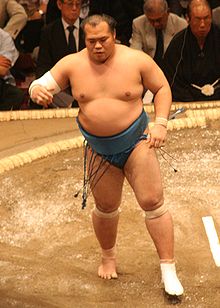- Chiyohakuhō Daiki
-
Not to be confused with Hakuhō Shō.
千代白鵬 大樹
Chiyohakuhō Daiki
Personal information Born Daiki Kakiuchi
April 21, 1983
Yamaga, Kumamoto, JapanHeight 1.80 m (5 ft 11 in) Weight 135 kg (300 lb; 21.3 st) Career Heya Kokonoe Record 343-296-50 Debut March, 1999 Highest rank Maegashira 6 (May, 2009) Retired April 2011 Yūshō 1 (Makushita)
1 (Jūryō)* Career information is correct as of Jan 2011. Chiyohakuhō Daiki (born 21 April 1983 as Daiki Kakiuchi) is a former sumo wrestler from Yamaga, Kumamoto, Japan. He made his professional debut in 1999 and broke into the top makuuchi division nine years later in 2008. His highest rank was maegashira 6. He wrestled for Kokonoe stable. After admitting his involvement in match-fixing, he retired from the sport in 2011 following an investigation by the Japan Sumo Association.
Contents
Career
At high school he preferred judo, and had little sumo experience, but his judo teacher was a friend of Kokonoe-oyakata, the 58th Yokozuna Chiyonofuji. After being introduced he joined Kokonoe stable, making his professional debut in March 1999. His heya mate, Chiyotaikai, made his debut at the rank of ozeki in the same tournament. He initially fought under his own surname, before adopting the shikona of Chiyohakuhō in November 1999. (He has no connection to the better known wrestler Hakuhō, who did not make his debut until March 2001.) He was first promoted to the third highest makushita division in November 2001.
Chiyohakuhō slowly climbed the makushita division and upon taking his first yusho or tournament championship in January 2005 with a perfect 7-0 record from the rank of Makushita 4 he earned automatic promotion to the elite sekitori ranks. However, he had to pull out of his debut tournament in the second highest jūryō division with an injury and fell back to makushita. He did not re-establish himself as a sekitori wrestler until May 2007. After six unremarkable tournaments he took the jūryō division championship with a 13-2 record in May 2008, and this was just enough to earn him promotion to the top makuuchi division at the lowest rank of Maegashira 16 West.
Chiyohakuhō came through with a bare majority of eight wins against seven losses in his top division debut in July 2008. He could only manage six wins in the next tournament but remained in the division, and a score of 9-6 in November pushed him up to maegashira 9 for the January 2009 tournament. He recorded six wins against nine losses there. Falling to maegashira 13, he produced a strong 10-5 record in March, which sent him up to what was to be his highest rank of maegashira 6.
He made a good start to the May 2009 tournament but was forced to pull out after damaging knee ligaments in his Day 4 defeat to Kisenosato.[1] He was demoted back to the jūryō division for July 2009 as a result. He was unable to secure an immediate return to the top division, scoring only 7-8 in the July tournament. In September 2009 he withdrew once again after winning only three bouts in the first ten days, and he remained in jūryō after that.
Controversy
In September 2008 Chiyohakuhō was the only wrestler who did not take part in the surprise drug tests of the 70 sekitori that led to the dismissals of Roho and Hakurozan. In June 2009, along with other members of the Kokonoe stable and four other heya, he was tested, and he expressed his relief at finally having done so.
He was suspended along with over a dozen other wrestlers from the July 2010 tournament after admitting involvement in illegal betting on baseball. As a result, he fell to the makushita division in September. This also left Kokonoe stable without any sekitori. However, he scored 6-1 from the rank of Makushita 5 West, enough for an immediate return to jūryō.
In February 2011, Chiyohakuhō reportedly admitted to fixing or throwing bouts in which he was involved in advance, after police investigating the baseball affair found text messages on his mobile phone apparently arranging the outcome of matches and discussing payments.[2] On February 4, he tendered his resignation to the Japan Sumo Association.[3] However, no decision on his future was made until an investigation into the affair by an independent panel concluded on April 1, when the Japan Sumo Association (JSA) announced the "advised retirements" of 21 wrestlers and two coaches. Because he admitted his involvement Chiyohakuho was given a two-year suspension instead, along with coach Takenawa (ex Kasuganishiki) and suspected go-between Enatsukasa. However, his letter of resignation was accepted.[4] Chiyohakuho gave a public apology, saying "I'm very sorry for causing trouble to the JSA and sumo fans."[5]
Fighting style
Like his stablemate Chiyotaikai, Chiyohakuhō favoured pushing and thrusting techniques, as opposed to grabbing the opponent's mawashi. His most common winning kimarite were oshi-dashi, the push-out, hataki-komi, the slap down, and tsuki-otoshi, the thrust over.[6]
Top division record
Chiyohakuhō Daiki [7]
year in sumo January
Hatsu basho, TokyoMarch
Haru basho, OsakaMay
Natsu basho, TokyoJuly
Nagoya basho, NagoyaSeptember
Aki basho, TokyoNovember
Kyūshū basho, Fukuoka2008 x x x West Maegashira #16
8–7
East Maegashira #13
6–9
West Maegashira #16
9–6
2009 West Maegashira #9
6–9
East Maegashira #13
10–5
West Maegashira #6
2–3–10
(Juryo) (Juryo) (Juryo) 2010 (Juryo) (Juryo) (Juryo) Jūryō
Suspended
0–0–15(Makushita) (Juryo) 2011 (Juryo) East Jūryō #14
Tournament Cancelled
0–0–0East Jūryō #14
Retired
––x x x Record given as win-loss-absent Top Division Champion Retired Lower Divisions
Sanshō key: F=Fighting spirit; O=Outstanding performance; T=Technique Also shown: ★=Kinboshi(s) P=Playoff(s)
Makuuchi ranks: Yokozuna — Ōzeki — Sekiwake — Komusubi — Maegashira
Divisions: Makuuchi — Jūryō — Makushita — Sandanme — Jonidan — JonokuchiSee also
- List of sumo tournament second division winners
- List of past sumo wrestlers
References
- ^ Hardy, James (15 May 2009). "Hakuho rides his luck to remain unbeaten". Daily Yomiuri. http://www.yomiuri.co.jp/dy/sports/20090515TDY24304.htm. Retrieved 15 May 2009.[dead link]
- ^ Hongo, Jun, and Natsuko Fukue, "Three admit to throwing sumo bouts", Japan Times, 4 February 2011, p.1.
- ^ "Sumo wrestler Enatsukasa emerges as bout-fixing coordinator". Mainichi Daily News. Archived from the original on 5 February 2011. http://www.webcitation.org/5wGnvK8nB. Retrieved 5 February 2011.
- ^ "Sumo: 3 top wrestlers hand in retirement papers over match fixing". Mainichi Daily News. 4 April 2011. Archived from the original on 4 April 2011. http://www.webcitation.org/5xgv9SwHy.
- ^ "Sumo wrestlers who deny involvement in bout-fixing angry about punishment". Mainichi Daily News. 2 April 2011. Archived from the original on 2 April 2011. http://www.webcitation.org/5xdw0Rlmp.
- ^ "Chiyohakuho bouts by kimarite". Sumo Reference. http://sumodb.sumogames.com/Rikishi_kim.aspx?r=89. Retrieved 15 May 2009.
- ^ "Chiyohakuho Daiki Rikishi Information". Sumo Reference. http://sumodb.sumogames.com/Rikishi.aspx?r=898. Retrieved 2008-12-31.
External links
Categories:- 1983 births
- Living people
- Japanese sumo wrestlers
- Sumo people from Kumamoto Prefecture
Wikimedia Foundation. 2010.

